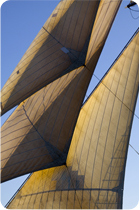 |
Tuesday, October 28 & Wednesday, October 29 - 8pm |
Programme notes
by Andrea Budgey
From Ulysses, the archetypal voyager of classical antiquity, to the 19th-century traveller Robert Louis Stevenson, from the interior journeys of Carl Sandburg to the utterly pragmatic migration patterns of 20th-century Canada, this programme investigates the phenomenon of human travel from a variety of angles.
Travel in the physical world is considerably less arduous now than it was in earlier ages. A modern traveller following Ulysses' peregrinations around the Aegean, or Robert Louis Stevenson's tracks through Great Britain, Europe, North America, and the South Pacific, will as a result have less occasion for self-discovery in the process. Exploration of the inner world of the soul remains, however, a risky and challenging business – potentially as much a voyage outward to alienation and strangeness as it is a voyage inward to peace and certainty. The readings and songs of this evening's programme reflect the diversity of human experience of human journeying – physical and spiritual, interior and exterior, toward and away from – revealing also the inseparability of these elements.
All the works on this programme make use of music's function as an art unfolding its meaning in time and intensifying our movement along the paths of the writers' imaginings. There is no stasis in music: sound travels to meet us, and we must also move toward it, transforming ourselves into receptive hearers of the both new and the familiar. We cannot stand twice in the same river.
Elisabeth Jacquet de la Guerre: Le Sommeil d'Ulisse. Text anonymous
Vally Weigl: Songs of Love and Leaving (excerpts). Poetry by Carl Sandburg
Four Strong Winds. Songs by Gordon Lightfoot, Joni Mitchell, Ian Tyson, arr. Laura Jones
Louis Applebaum: Algoma Central. Text from the brochures and timetables of the Algoma Central Railway
Ralph Vaughan Williams: Songs of Travel. Poetry by Robert Louis Stevenson
Elisabeth Jacquet de la Guerre (1665-1729): Le Sommeil d'Ulisse (1715) for soprano, violin, flute and continuo. Text anonymous
Elisabeth Jacquet de la Guerre was one of the most prominent female musicians of the early 18th century. From the age of five, she was a favourite performer at the court of Louis XIV, particularly of the king's mistress, Madame de Montespan. She became known for her skill as an improviser, and after her marriage to the organist Marin de la Guerre, she performed and taught throughout Paris and at her home. As a composer, she produced keyboard and chamber music, an opera and a ballet, and fifteen cantatas on themes from scripture and classical mythology.
Le Sommeil d'Ulisse, published in 1715 as part of the composer's final set of Cantates françoises, depicts the moment in Ulysses' long voyage home from the Trojan War when a jealous Neptune attacks his fleet. Following an opening simphonie, a recitative and air set the scene. Then follows a remarkably dramatic Tempêste, a cascade of repeated sixteenth notes and sweeping chromatic "waves" that marks the temporary victory of the god. The narrator, however, calls on Minerva, goddess of wisdom and Ulysses' divine patron, who rescues the hero by means of a charmed sleep, or sommeil, and promises him a triumphant return home.
The "dream sequence" features rocking dotted figures, moving in a gentle triple rhythm to support the voice. Both the tempêste and the sommeil were established genres of the French baroque cantata, and Jacquet de la Guerre's combination of the two in this work is particularly original and inventive, both vocally and instrumentally.
Vally Weigl (1894-1982): Songs of Love and Leaving (1981) for baritone, viola and piano. Poetry by Carl Sandburg
The Austrian-American composer Valerie Weigl studied piano, composition, and musicology in Vienna, but left for the United States with her husband and son after the Nazi Anschluß in 1938. They settled in New York, and she resumed her career as a composer and teacher. She also became one of the pioneer researchers and practitioners of music therapy in North America, serving a stint as chief medical therapist at New York Medical College. Her extensive list of compositions includes a number of works for orchestra and for various chamber music configurations, many including the voice.
The movements of Songs of Love and Leaving are all settings of poems by Carl Sandburg, from various of his published collections. The individual songs were composed between 1965 and 1980, and subsequently assembled into a cycle.
The "leaving" of the title would appear to be a final departure, as intimated by the first poem, but the texts focus on the cognitive, emotional, and physical processes of this farewell, unfolding in time – on preparation rather than on abrupt loss. Weigl's compositional vocabulary in these songs is broadly tonal, and neo-romantic in spirit. The instrumental lines provide a smooth matrix for the vocal part, creating a fully integrated counterpoint within the ensemble, and a satisfying overall unity.
Four Strong Winds: Canadian travelling songs by Gordon Lightfoot, Joni Mitchell, and Ian Tyson, for two singers, strings and oboe, arr. Laura Jones
For this distinctively Canadian set, Talisker cellist Laura Jones has arranged three great travel classics of Canadian popular song.
Joni Mitchell's "Blue Motel Room" is from the 1976 album Hejira, whose title comes from the Arabic for "journey" and refers not only to Mitchell's own relentless touring schedule, but also to the Muslim tradition of pilgrimage to Mecca. The song's focus is not on the act of travelling, but rather on the absence and return of the traveller, on separation from a lover, and on the resulting break or gap in the relationship. The mood is melancholy but relaxed, with a bluesy rhythm, and the oboist takes a turn as percussionist, imitating the sound of brushes on snares with blocks of sandpaper.
Gordon Lightfoot's "Early Mornin' Rain" was originally released on his 1966 debut album, and has since been recorded by numerous other performers. Jones has given the driving guitar rhythms to the strings, and extracted from the harmony a simple but eloquent obbligato line for the oboe. Lightfoot's narrator is kept from home and loved ones by a run of bad luck and hard living, as well as great distance, and sees no prospect of return; unlike the hobos of earlier generations, he cannot simply hop a freight train to end the separation.
"Four Strong Winds" was chosen by a 2005 CBC listeners poll as the greatest Canadian song of all time. Written by Ian Tyson in the early 1960s and premièred with his wife Sylvia (née Fricker), it has been covered by dozens of other performers, and translated into many other languages. The mood of imminent departure, and dissolution of a relationship, with a rather forlorn hope of a possible future reconciliation, has a particular resonance in the Canadian popular imagination – in part because of the marriage and subsequent split of Tyson and Fricker. The simple, powerful harmonies of the original version are well served by the transparent and supportive instrumentation of Jones' arrangement.
Louis Applebaum (1918-2000): Algoma Central (1976) for soprano, flute and harp. Text from the brochures and timetables of the Algoma Central Railway.
Composer, conductor, and arts administrator Louis Applebaum was based in Toronto for most of his life. He studied with Boris Berlin, Healey Willan, and Sir Ernest MacMillan, and is known for numerous film and television scores as well as for his concert music. He was the first musical director of the Stratford Festival, and composed the festival's signature trumpet fanfare. He also served as the executive director of the Ontario Arts Council and vice-president of the Canadian League of Composers.
Algoma Central (subtitled "In the tracks of the black bear") was given its première on September 19, 1976, at the Algoma Festival in Sault Ste Marie, by soprano Mary Morrison, with Robert Aitken, flute, and Erica Goodman, harp. The title is in keeping with Applebaum's expressed preference for allusive and open-ended titles, avoiding any suggestion of conventional forms.
The texts of the piece's various segments are taken from brochures and timetables of the Algoma Central Railway, and this anti-narrative structure is juxtaposed with a briskly dissonant style, including some use of vocal and instrumental onomatopoeia. The light-hearted effect of this combination was clearly not grasped by the first reviewer, who commented "Soprano hisses, clucks, howls her way through ACR commercial", but subsequent generations of audiences have shown a livelier appreciation for Applebaum's clever and bracing work.
Ralph Vaughan Williams (1872-1958): Songs of Travel (1904) for voice, string quartet and piano, arr. Harold Birston. Poetry by Robert Louis Stevenson.
Vaughan Williams began work on what would eventually become the Songs of Travel in 1901, with "Whither must I wander?" The cycle was first performed in 1904, but was published piecemeal and out of sequence over the next few years. Only in 1960 was the brief epilogue "I have trod the upward and the downward slope" discovered among the composer's papers, with an indication that it was never to be performed separately from the first eight songs.
The cycle, which some have seen as a characteristically English response to such collections as Schubert's Die Winterreise and Mahler's Lieder eines fahrenden Gesellen, had a considerable impact on a new generation of composers: Arthur Bliss, who was studying at Cambridge between 1910 and 1913, wrote "To us musicians in Cambridge Vaughan Williams was the magical name; his Songs of Travel were on all pianos".
The complex emotional palette of the Songs of Travel ranges, without any explicit narrative framework, from the vagabond's robust pleasure in the freedom of the road, through the memory of departed love, the loss of home, and the imperishability of beauty, to the resolute acceptance of finality. The energetic tramping rhythms of "The vagabond", the rapturous arpeggios of "Let Beauty awake", and the playfulness of "The roadside fire" reflect the carefree romanticism of Robert Louis Stevenson's texts. The tension between tenderness and separation, however, is set out in "Youth and Love" and "In dreams" – the first light and fluid, full of the delight of exploration, the second static, bound by memories both happy and unhappy. "The infinite shining heavens" offers the timeless consolation of nature's beauty in arioso lines over hushed chords in the strings and piano, but the sweeping lines and rhythmic restlessness of "Whither must I wander?" underline the pain of the traveller's exile. "Bright is the ring of words" returns to the theme of beauty; a declaratory opening chord prepares the assertion that art has a life of its own and that words and songs outlive their makers.
"I have trod the upward and the downward slope" provides, in twenty-five measures, an extraordinary conclusion to the cycle. It quotes "The vagabond", "Whither must I wander?" and "Bright is the ring of words", encapsulating and summarising the wanderer's journey as it draws to its close.
From the original version for voice and piano, Vaughan Williams orchestrated three of the songs – "The Vagabond", "The Roadside Fire", and "Bright is the Ring of Words" – for full symphony. Roy Douglas, who acted as his assistant through the last decade of his life, later completed the orchestration of the remaining songs. Tonight's version, for voice, string quartet and piano, was arranged by Vancouver composer and conductor Harold Birston in 2007.
.
 |
 |
